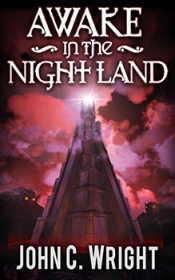 Quick review: buy and read it, already! Lots of fun, full of cool sci-fi speculation, and another cliff-hanger or two. Trends are extrapolated, worlds built and moral quandaries examined.
Quick review: buy and read it, already! Lots of fun, full of cool sci-fi speculation, and another cliff-hanger or two. Trends are extrapolated, worlds built and moral quandaries examined.
The 4th novel in John C. Wright’s Count to a Trillion hexology, The Architect of Aeons takes up the story of Menelaus Montrose and Ximen del Azarchel after they were exiled from earth at the end of The Judge of Ages by the very post-humans Montrose had engineered to defeat del Azarchel’s schemes. Meany wants people to be free; Blackie wants to bioengineer people to be better slaves to the soon to arrive super-intelligences from Hyades. And they are both in love with the same woman – who took a little trip to M3 and won’t be back for millennia.
Meany and Blackie wake from stasis after the Hyades, having won an epic battle, swept the earth of most of its inhabitants and shipped them off to various nearby (sidereally speaking) planets. It seems that the economics of the Hyades and their masters indicate that the only value people have in the big scheme of things is to work to ‘wake up’ various planets and stars by converting the bulk of their masses to logic crystal. That the people of earth in their present state are fatally unfit for this work doesn’t matter – the Hyades seed many planets with people by simply dumping them there, whether or not those worlds are suitable for (post) human life.
The people of earth must adapt or die. Further, the Hyades will be back in a few millennia for another sweep. Much of the first part of the book is concerned with what Montrose does to try to defend earth against this second attack. Meanwhile, del Azarchel heads off the the Sagittarius Arm with a bunch of his heavily modified minions to check out another contraterrene star and monument. The second sweep and Montrose’s planned war against it take place while Blackie is gone.
It does not go as planned. It does not go well. The theme of these books might be: the best laid plans of mice and cliometricians…
Montrose, a man who insists on freedom, who is a bit put out that some poxy Yankee state got the motto that rightfully belongs to his Texas – Live Free or Die – is a cliometric singularity. Funny things happen, mathematically speaking, wherever he treads. So the Hyades give him a choice.
The last bit of this book was my favorite by far, one of my favorite sections in the whole series. Wright channels Cordwainer Smith (specifically, Alpha Ralpha Boulevard and The Ballad of Lost C-mell sprang to mind) and Jack Vance. After Montrose cut his deal with the Hyades, the various creatures of earth origin develop elaborate cultures – no more elaborate than, say, Italian Renaissance courtly culture, but, needing to incorporate the social implications of space-faring, as well as all sorts of biotech and nanotech and what have you. The story achieves the sort of bizarre yet believable formality that Vance trafficked in, as well as his penchant for detective stories and gasping reveals. Totally fun.
This book gives the reader more insight into del Azarchel’s character. Wright walks the fine line between making him sympathetic, but not too sympathetic – you feel sorry for the guy, for sure, but still want him to lose big.The book ends with choice, where a creature with (to us) godlike powers lays them down for something she knows is better. Del Azarchel cannot believe it – and that’s the point.
Architects of Aeons is one of, if not the, best book in the series. I’ll readily admit that this assessment is partly the result of Wright’s deft echos of Cordwainer Smith and Jack Vance (and probably other writers I don’t know as well – that’s for someone else to comment on). But the thinking is deepening, too. The philosophical speculations that are the backbone of the hexology are coming into sharper focus, and the longer term implication of what man decides to do are laid out across eons. We are all cliometric singularities, after all – that’s what Free Will means. Ultimately, vast historical calculus is not the work of men, nor angels. We don’t throw the switch and KNOW that the trolley will kill the man in the alley (or that that is the best outcome if it were to happen); we don’t KNOW that if we just kill enough of the right people, the worker’s paradise will spontaneously arise. We only know that it is good to love, good to be loved, and that life and this universe are achingly beautiful – and we should be on the side of that life and beauty, even if, especially if it costs us.
Go read the book! I’m ready for Volumes 5 and 6.






